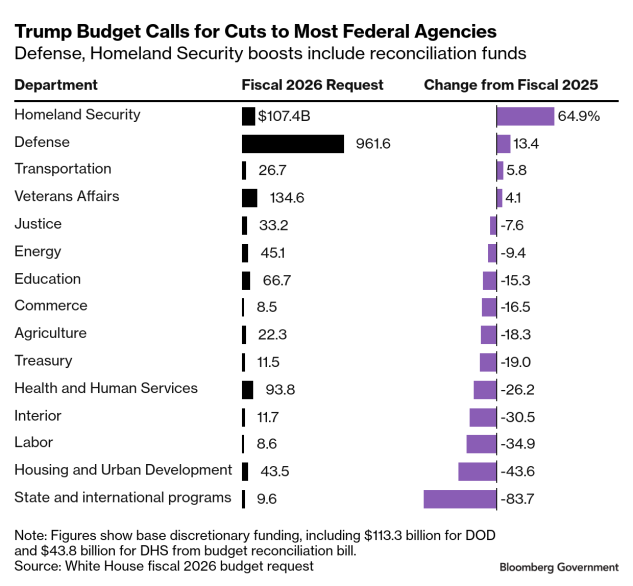President Donald Trump is banking on Republicans slashing domestic funds and successfully shepherding a fraught tax-and-spending package through Congress, as he sends lawmakers a budget proposal focused heavily on military and border priorities.
Trump released a fiscal 2026 spending proposal — called a “skinny budget” because it’s light on details — Friday morning, allowing Congress to start preliminary work to fund the government beyond Sept. 30. The plan calls for a 17% cut to nondefense discretionary spending, including steep cuts to environmental, agricultural, and housing programs.
Trump is seeking a 13% boost for national security spending, though that’s dependent on a broader, complex tax-and-spending package Republicans aim to enact through the reconciliation process, which allows them to sidestep the Senate’s 60-vote filibuster.
Overall, the figures equate to a freeze in federal discretionary spending, which would equate to a reduction in purchasing power, adjusted for inflation.
The budget outline arrives as GOP lawmakers are getting antsy to start government-funding work. The House Appropriations Committee has a series of hearings set for next week on cabinet officials’ spending priorities. That includes subcommittee hearings with Treasury Secretary Scott Bessent and Homeland Security Secretary Kristi Noem.
“There is a big hurry on the ‘skinny budget,’” House Appropriations Chairman Tom Cole (R-Okla.) told reporters Thursday. “We’ve got a lot of cabinet officials coming up literally next week. It’s hard to ask them intelligent questions if you don’t have some idea of what we’re going to have in it.”
Trump’s austere approach to domestic spending may face challenges, even in a friendly GOP-controlled Congress. Cole and other Republicans have pushed back on some spending-cut proposals that would affect their own districts. And a separate proposal to claw back $9.3 billion in old foreign-aid and public broadcasting money “sounds like a lot of money to me,” Cole told reporters Thursday.
Nondefense spending would fall by $119.3 billion under Trump’s plan. That includes adjustments based on Republicans’ reconciliation proposals, which would be passed separately from the usual government-funding bills.
Defense spending would see an equivalent $119.3 billion increase under the proposal which assumes GOP lawmakers meet the targets they’ve set for themselves in the budget reconciliation process.
The Department of Homeland Security would see a significant boost in funding of almost 65% under the proposal — up to $107.4 billion from $65.1 billion — which includes the money from the GOP’s reconciliation plan to fund the Trump administration’s border and deportation strategy.
Trump aims to mostly do away with funding for the State Department and other foreign aid. State and international programs would receive $9.6 billion in fiscal 2026, down from $58.7 billion this year — an 83.7% drop. Those cuts are partly contingent on proposals to rescind old funds.
The Health and Human Services Department would see a 26.2% cut. Housing and Urban Development programs would see a 43.6% cut. The Department of the Interior faces a 30.5% reduction. And the Labor Department would get a 34.9% reduction.
To contact the reporters on this story:
To contact the editors responsible for this story:



